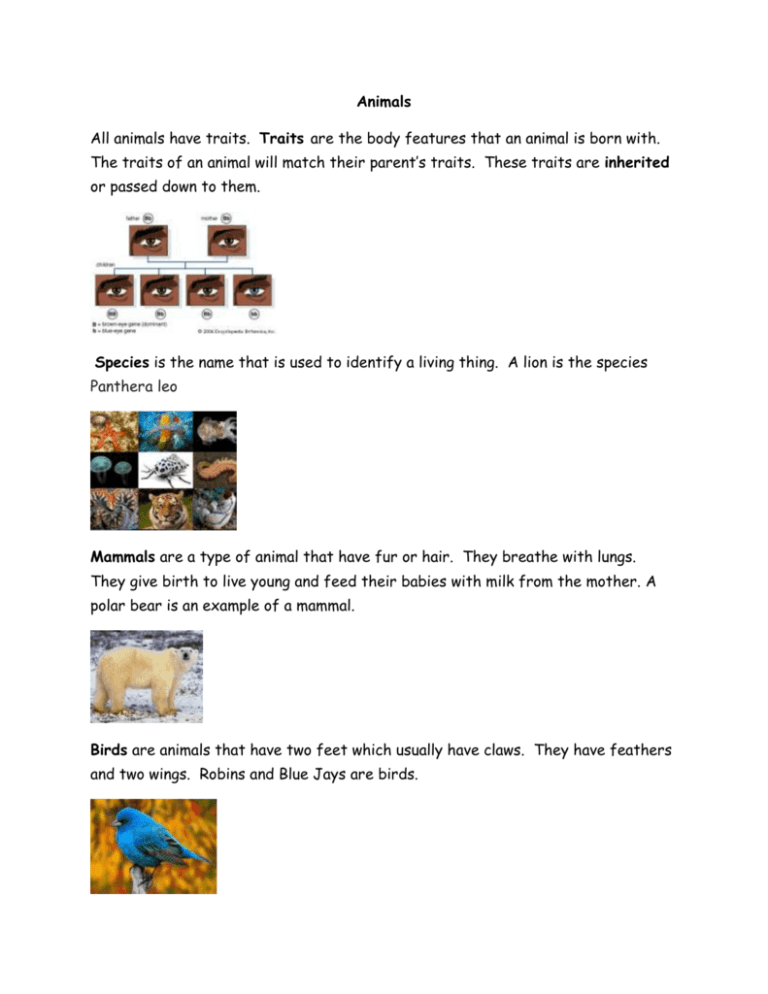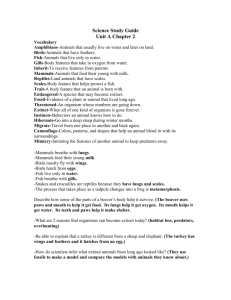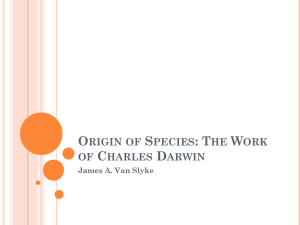Animals All animals have traits. Traits are the body features that an
advertisement

Animals All animals have traits. Traits are the body features that an animal is born with. The traits of an animal will match their parent’s traits. These traits are inherited or passed down to them. Species is the name that is used to identify a living thing. A lion is the species Panthera leo Mammals are a type of animal that have fur or hair. They breathe with lungs. They give birth to live young and feed their babies with milk from the mother. A polar bear is an example of a mammal. Birds are animals that have two feet which usually have claws. They have feathers and two wings. Robins and Blue Jays are birds. Amphibians are both land and water animals. They begin life in the water with gills. As they grow to be adults, they develop lungs. They have smooth skin. They lay eggs. Frogs and toads are amphibians. Reptiles have dry, scaly skin. They are land animals that breathe with lungs. They lay eggs. Lizards and snakes are reptiles. Fish are water animals. They breathe with gills. They have scales to protect themselves. Goldfish and sharks are fish. Scales are small, thin, flat plates that protect the bodies of fish and reptiles. Gills are used to take oxygen from the water to allow water animals to breathe. Cells are the small units that make up all parts of all living things. An animal whose population numbers are getting smaller are considered to be Threatened. Some sea turtles are threatened. An animal is Endangered when the number of the species remaining is low enough that it could become extinct. A giant panda is endangered. Extinct animals are gone forever because the entire species has died out. Dinosaurs are extinct. A Fossil is evidence of an animal that lived long ago. Some examples of Fossils can be a mold, cast or imprint. An Instinct is something an animal knows how to do without being taught. Hibernation is something animals do by instinct. Hibernation is when an animal goes into a deep sleep and all life activities like breathing slow down. Bears hibernate in the winter. Some animals Migrate during certain months of the year. They travel together as a group from one place to another to live. Many birds and monarch butterflies migrate in the winter Camouflage is a way an animal disguises itself to blend into its surroundings. This is to protect itself from predators. Leaf bugs camouflage themselves. Mimicry is another animal disguise. Animals try to copy or look identical to a more deadly or less tasty animal to keep from being eaten. Viceroy butterflies look like monarch butterflies to protect themselves. A Producer makes its own food. Plants are producers. A Consumer has to eat other living things for food. Bugs are one example of a consumer. Predator hunts other animals for food. Lions are predators. Prey is the animals that are hunted by other animals as a source of food for the other animal. Bugs are often prey for other animals. A Food Chain is the path of food from one living thing to another – what are predators, what are prey and what are both. A Food Web is a model that shows how food chains in an ecosystem overlap. Omnivores eat both plants and animals. Bears are examples of omnivores. Carnivores eat only other animals for food. Lions are examples of carnivores. Herbivores eat only plants for food. Deer are herbivores. Decomposers break down dead organisms for food. Earthworms and fungi are examples of decomposers. Energy pyramid is a model to show the amount of energy for an ecosystem. The higher on the energy pyramid you are, the less energy you get from each living thing you consume. Producers are on the bottom of the energy pyramid and have the most energy. Animals that are high on the food chain are also on the top levels of the energy pyramid. This means they have to eat more to get the same amount of energy as the producers on the bottom.







